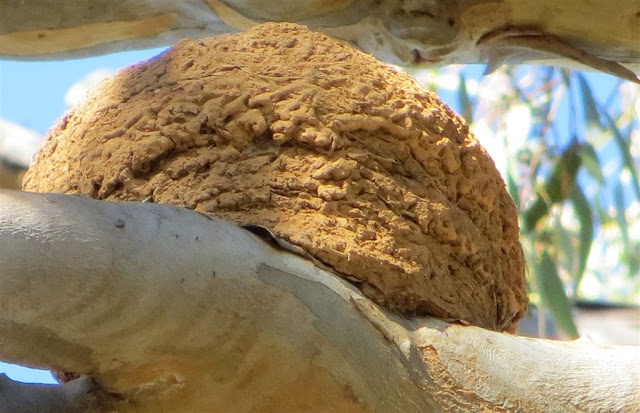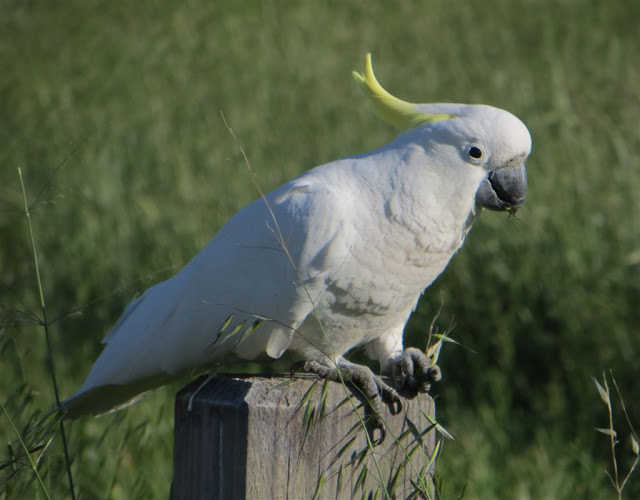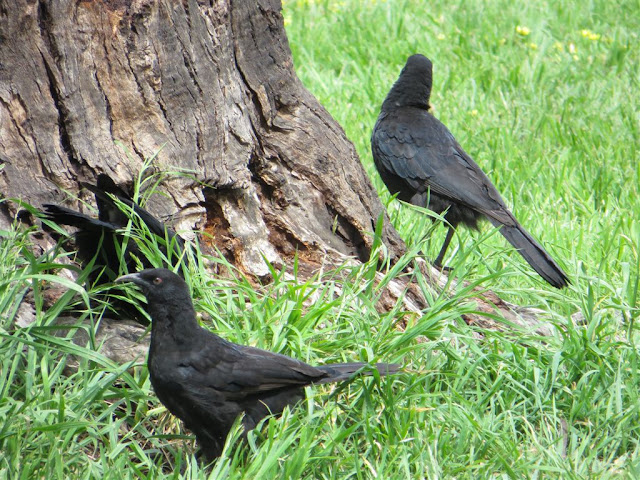I knew Alouette would be handy some day.
This blog is to share my photographs of, and enthusiasm for, the native birds living around and passing by the base of Mount Majura, Canberra, Australia. It was inspired by the swanlings at the bottom of my street. All photographs have been taken on local walks.
Wednesday, 31 October 2012
le bec
Another swanling development is the red beak colouration, which is noticeably resembling the adult birds.
I knew Alouette would be handy some day.
I knew Alouette would be handy some day.
Tuesday, 30 October 2012
So the hollows in trees don't always come easy?
I've read it usually takes a hundred years before a gum can develop the kinds of hollows required for breeding by many native birds and animals, which is one reason old trees are important. In this instance a hollow already existed, but the galah was determinedly improving on it. Maybe this is why galahs and parrots need such strong beaks and claws.
Monday, 29 October 2012
Majura turtle
The local pond may be full of scum but it is obviously clean enough to sustain a variety of bird and aquatic life. This is a fair sized turtle. Maybe it's a Long-necked Turtle.
Australian Reed Warbler
What sits in the reeds, in erm.. Australia and warbles a lot? You got it? I had no idea so thanks SG for identifying this tiny bird for me.
Australian Reed Warblers are resident at the local swan pond right now. Favouring the heard but not seen approach, they spend the days warbling loudly, flitting in and out of the reeds and over the water at high speed and desperately avoiding portrait posing situations.
Australian Reed Warblers are resident at the local swan pond right now. Favouring the heard but not seen approach, they spend the days warbling loudly, flitting in and out of the reeds and over the water at high speed and desperately avoiding portrait posing situations.
Sunday, 28 October 2012
Australian Wood Duck
Who could have imagined it would be hard to photograph one of these ducks in spring? In past years they have bred in this pond, with ducklings galore, but right now they are infrequent visitors. This morning a pair scudded in, only to decide they did not want to share the pond with an energetic golden retriever and soon departed. Monsieur is pictured. Madame was less co-operative.
Saturday, 27 October 2012
Noisy Friarbird
O what a beautiful morning!
Noisy Friarbirds are baldest of the friarbirds and I believe the name Friarbird proves that at least one person involved in English nomenclature of Australian birds, had a sense of humour. Hallelujah!
Silvereye
Not my most splendid photograph but do you see what I see in the next one?
Yes, it's a Silvereye hijacking a celery top. Guard your salad!
Pied Currawong
As a child, currawongs were the first Australian birds I learnt to distinguish. Similar in size and colour to magpies, they are easy to tell apart close up, by the yellow eye outline, and in flight, by the white window on the otherwise black wing.
Adaptive, some currawongs near my workplace, nested high in a deciduous tree this year. Complete exposure did not appear to be a concern. I've seen one hatchling in the nest in the last week and the tree is only just starting to green up.
Adaptive, some currawongs near my workplace, nested high in a deciduous tree this year. Complete exposure did not appear to be a concern. I've seen one hatchling in the nest in the last week and the tree is only just starting to green up.
Thursday, 25 October 2012
Superb Fariywren
Superb Fairywrens are common backyard birds and I've lived places where they are plentiful and come close to people. That is not the situation here, where Magpies, Currawongs, Miners, Mynas and Starlings rule the roost. These tiny fairywrens need the protection of the undergrowth and it is easy to see how their range becomes restricted.
This male was photographed on the mountain. I'll work on getting a clearer photo in due course, but the last thing I want to do is disturb these beautiful wrens.
This male was photographed on the mountain. I'll work on getting a clearer photo in due course, but the last thing I want to do is disturb these beautiful wrens.
White-winged Chough nest
Conveniently, some choughs made their mud nest right over a walking track on lower Mount Majura. Choughs are earth construction experts.
Transitional Crimson Rosella
I'm pretty sure this is the Crimson Rosella equivalent of 'awkward teenager'. Some day soon it will transform into a confident, cheerful fellow, just like its parent (below).
Monday, 22 October 2012
Mynas and Starlings
Unfortunately for native birds, introduced Generals and Majors, oh sorry I mean Mynas and Starlings are established in the bushland fringe bordering Mount Majura. Unlike in cities and towns, these birds do not stay in close proximity to people, preferring the treetops. In direct competition with native species, their eradication did not appear to be a hot topic at the recent ACT election.
Common Starlings
Common Myna
Out in a world of their own
They'll never come down
They'll never come down
XTC
Sunday, 21 October 2012
White-necked Heron
Canberra Ornithologists Group list the White-necked Heron as an uncommon visitor to this area so I was lucky to see one this afternoon. They are enormous. This one was at a small dam, not the swan pond.
Saturday, 20 October 2012
Noisy Miner
What noise annoys a Noisy Miner? Everything. Nothing. These are the most aggravating, annoying native birds I know of and I am sure their overabundance is linked to urban development. Development means loss of old growth and undergrowth that many native birds require, however these miners thrive. And chase off everything else leading to diversity loss. So bold the miners will scuttle people, kangaroos and all birds, big and small. I'm happy that includes the local populations of Common Mynas and Starlings, but that is the nicest thing I can say about them.
Raven
They saw a big raven; it glided down the sky, she touched it... though I doubt an Australian Raven is what Björk had in mind when she was just a young Sugarcube.
This post is more art than ornithology. I'm not sure which raven this is. I have seen many very large, Australian Ravens over the years in countryside and in towns, and the small group of ravens in the bushland this morning, of which this is one, were not plus sized like those. So it is possibly a Little Raven but more likely a less well fed, good old garden variety, Australian Raven. You may know it by another name. Crow.
Btw, the fantastic Sugarcubes song quoted above is called Birthday.
This post is more art than ornithology. I'm not sure which raven this is. I have seen many very large, Australian Ravens over the years in countryside and in towns, and the small group of ravens in the bushland this morning, of which this is one, were not plus sized like those. So it is possibly a Little Raven but more likely a less well fed, good old garden variety, Australian Raven. You may know it by another name. Crow.
Btw, the fantastic Sugarcubes song quoted above is called Birthday.
Common Bronzewing
The Noisy Miners and other pesky birds were not happy about this Bronzewing occupying any branch, on any tree, on the mountain, but they eventually left it alone.
These pictures are of the same bird. The wingsheen is amazing.
These pictures are of the same bird. The wingsheen is amazing.
Red-rumped parrot
This Red-rumped Parrot, with its partner, were feeding on grass seeds by a road this morning. They are really beautiful small parrots. I have not seen one in many years.
In the final picture you can see my best shot of the famous red rump. Who names these birds?
In the final picture you can see my best shot of the famous red rump. Who names these birds?
Tuesday, 16 October 2012
Mid October Swanlings
This is my second swanling post. I added to the last one many times but now there is a real development. Feathers!
A lot of the human chat around the pond is about whether the babies are getting feathers or are still covered in fluff and I have to admit I've not lost much sleep wondering which feathers might grow first on swans or any baby birds at all. If anything I'd have imagined a nice even coverage... But that's not how it is. The swanlings are growing wing and tail feathers first, and it makes perfect sense now I fhink about it because it's wings and a tail that will assist survival and escaping harm, more than anything else. I have noticed how vulnerable the swanlings are when they are away from the pond. Presently they rely on fire-breathing, protective parents, and fast waddling.
Some of the swanlings are more advanced than others with the wing feathers, but if you look closely in this picture, you can see what I am talking about.
Here is a view from above on the viewing platform. Notice also the leg out of the water. This is a regular posture for both parents and the baby swans. I don't know what it is about. To dry out a bit?
20th October
26th October
Feather growth is rapid now on the wings and tails. There are small feathers on the necks also.
29th October
Here is a swanling in the water pipe that feeds the pond. You can see the white wing patch is starting to develop. The tails are well developed and it's hilarious watching the swanlings shake them.
A lot of the human chat around the pond is about whether the babies are getting feathers or are still covered in fluff and I have to admit I've not lost much sleep wondering which feathers might grow first on swans or any baby birds at all. If anything I'd have imagined a nice even coverage... But that's not how it is. The swanlings are growing wing and tail feathers first, and it makes perfect sense now I fhink about it because it's wings and a tail that will assist survival and escaping harm, more than anything else. I have noticed how vulnerable the swanlings are when they are away from the pond. Presently they rely on fire-breathing, protective parents, and fast waddling.
Some of the swanlings are more advanced than others with the wing feathers, but if you look closely in this picture, you can see what I am talking about.
Here is a view from above on the viewing platform. Notice also the leg out of the water. This is a regular posture for both parents and the baby swans. I don't know what it is about. To dry out a bit?
20th October
26th October
Feather growth is rapid now on the wings and tails. There are small feathers on the necks also.
29th October
Here is a swanling in the water pipe that feeds the pond. You can see the white wing patch is starting to develop. The tails are well developed and it's hilarious watching the swanlings shake them.
Sunday, 14 October 2012
Gang-gang Cockatoo
A sighting of a red crested Gang-gang in Canberra = a red letter day for me! Given that the Gang-gang is the avian emblem of the Australian Capital Territory, I wish sightings were more frequent.
This male was sleepy but was roused by my interest.
This male was sleepy but was roused by my interest.
Sulphur-crested Cockatoo
A Sulphur-crested Cockatoo not being raucous, for a minute. This one needs a bath.
And another quiet one.
And another quiet one.
Welcome Swallow
These swallows are everywhere. The nest is above a front door in my neighbourhood. Not necessarily welcome.
Saturday, 13 October 2012
Inbred chough?
White-winged choughs live in many parts of Canberra and frequent parks and gardens as well as bushland. They are birds of great character, trotting about in groups of six or more. One year a lone, young chough lived in our driveway for a while, having been abandoned due to a broken wing. All the neighbours considered it their own private chough.
The first photo shows regular looking choughs. I'm sorry you can't see the white window on the wing. However amongst this group I saw today, were some choughs with malaligned beaks. My husband suggested this deformity might be due to inbreeding. Has anyone observed this before?
The first photo shows regular looking choughs. I'm sorry you can't see the white window on the wing. However amongst this group I saw today, were some choughs with malaligned beaks. My husband suggested this deformity might be due to inbreeding. Has anyone observed this before?
Friday, 12 October 2012
Grammar mini break
I am fond of the -ling words, such as duckling, gosling, fledgling, nestling and even swanling, where the -ling makes something small or young. (I'm sure Hagrid would know the full set.) They interest me as they sound so particular to English, entering around the 14th century and lets face it, foundlings are not commonplace in my world. I suspect other words such as puffling for baby puffin entered the lexicon later. I know that moshling, for the pet of a moshi monster, is fairly recent!
Let me know if you think of other -ling words which fit in my set.
On the wallaby track
Cute wallabies and other mammals may also appear on this blog from time to time. I saw four 'waballies' this afternoon but larger groups are common. Look how well camouflaged they are.
Darter
I have not seen a Darter at our local pond since winter, so I was very happy to see one get a casual visitor pass there today. This one stuck around quite a while, had a swim and made a loud clacking noise at times. It also did its 'wings pegged out to dry' routine then posed for the camera in classic Darter style, if a little self conscious. I hope it will return for a repeat performance soon.
13th October
Yay the darter is still there!
Thursday, 11 October 2012
Junior Maggie
I have not been swooped by magpies this season though my husband came home a few weeks ago, with blood and gashes on his head, having been swooped on Mount Ainslie. He was cycling and I think helmets drive the magpies extra mad. Now the young magpies are hatched, the parent birds are in constant service and are less concerned about foot traffic.
If you know the sound of magpie hatchlings demanding to be fed, with the cries growing louder and more frenzied as the parents approach, it is easy to locate magpie nests right now. I've had the chance to observe a few nests over the years and I admire the parents' dedication. One year the nestlings were cleared out by currawongs and the parents stayed around the tree for days afterwards. Not that there's a shortage of magpies, it was a sad affair.
In the following photo you can see a not too bright fledgling, that fledged too soon. It was not even able to walk properly and used its wings for balance. One parent was close by and feeding it, but its chances of returning to the nest seemed slight to me.
And here is a standard issue Australian Magpie. Judging by its sleek, clean look it is young. Older magpies get dusty.
Yet another common sight; a magpie sitting on a street, carolling away, oblivious to passersby.
My mum in northern NSW, says some of their magpies only ever walk. They've dispensed with the effort of flight!
If you know the sound of magpie hatchlings demanding to be fed, with the cries growing louder and more frenzied as the parents approach, it is easy to locate magpie nests right now. I've had the chance to observe a few nests over the years and I admire the parents' dedication. One year the nestlings were cleared out by currawongs and the parents stayed around the tree for days afterwards. Not that there's a shortage of magpies, it was a sad affair.
In the following photo you can see a not too bright fledgling, that fledged too soon. It was not even able to walk properly and used its wings for balance. One parent was close by and feeding it, but its chances of returning to the nest seemed slight to me.
And here is a standard issue Australian Magpie. Judging by its sleek, clean look it is young. Older magpies get dusty.
Yet another common sight; a magpie sitting on a street, carolling away, oblivious to passersby.
My mum in northern NSW, says some of their magpies only ever walk. They've dispensed with the effort of flight!
Subscribe to:
Posts (Atom)















 ,
,

































